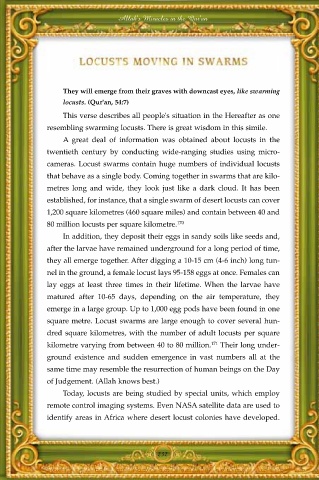Page 234 - Allah's Miracles in the Qur'an
P. 234
Allah's Miracles in the Qur'an
They will emerge from their graves with downcast eyes, like swarming
locusts. (Qur'an, 54:7)
This verse describes all people's situation in the Hereafter as one
resembling swarming locusts. There is great wisdom in this simile.
A great deal of information was obtained about locusts in the
twentieth century by conducting wide-ranging studies using micro-
cameras. Locust swarms contain huge numbers of individual locusts
that behave as a single body. Coming together in swarms that are kilo-
metres long and wide, they look just like a dark cloud. It has been
established, for instance, that a single swarm of desert locusts can cover
1,200 square kilometres (460 square miles) and contain between 40 and
80 million locusts per square kilometre. 170
In addition, they deposit their eggs in sandy soils like seeds and,
after the larvae have remained underground for a long period of time,
they all emerge together. After digging a 10-15 cm (4-6 inch) long tun-
nel in the ground, a female locust lays 95-158 eggs at once. Females can
lay eggs at least three times in their lifetime. When the larvae have
matured after 10-65 days, depending on the air temperature, they
emerge in a large group. Up to 1,000 egg pods have been found in one
square metre. Locust swarms are large enough to cover several hun-
dred square kilometres, with the number of adult locusts per square
kilometre varying from between 40 to 80 million. 171 Their long under-
ground existence and sudden emergence in vast numbers all at the
same time may resemble the resurrection of human beings on the Day
of Judgement. (Allah knows best.)
Today, locusts are being studied by special units, which employ
remote control imaging systems. Even NASA satellite data are used to
identify areas in Africa where desert locust colonies have developed.
232

